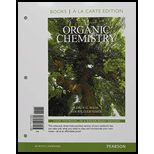
Concept explainers
(a)
Interpretation:
The multiplicity and the chemical shifts for each shaded protons in the given compound are to be determined.
Concept introduction:
The chemical shift is defined as the difference in parts per million in the absorption spectrum of a particular proton from the absorption position of a reference proton. Tetramethylsilane is taken as the reference proton. Chemical shifts are measured in parts per million and it is dimensionless quantity.
(b)
Interpretation:
The multiplicity and the chemical shifts for each shaded protons in the given compound are to be determined.
Concept introduction:
The chemical shift is defined as the difference in parts per million in the absorption spectrum of a particular proton from the absorption position of a reference proton. Tetramethylsilane is taken as the reference proton. Chemical shifts are measured in parts per million and it is dimensionless quantity.
(c)
Interpretation:
The multiplicity and the chemical shifts for each shaded protons in the given compound are to be determined.
Concept introduction:
The chemical shift is defined as the difference in parts per million in the absorption spectrum of a particular proton from the absorption position of a reference proton. Tetramethylsilane is taken as the reference proton. Chemical shifts are measured in parts per million and it is dimensionless quantity.
(d)
Interpretation:
The multiplicity and the chemical shifts for each shaded protons in the given compound are to be determined.
Concept introduction:
The chemical shift is defined as the difference in parts per million in the absorption spectrum of a particular proton from the absorption position of a reference proton. Tetramethylsilane is taken as the reference proton. Chemical shifts are measured in parts per million and it is dimensionless quantity.
(e)
Interpretation:
The multiplicity and the chemical shifts for each shaded protons in the given compound are to be determined.
Concept introduction:
The chemical shift is defined as the difference in parts per million in the absorption spectrum of a particular proton from the absorption position of a reference proton. Tetramethylsilane is taken as the reference proton. Chemical shifts are measured in parts per million and it is dimensionless quantity.
(f)
Interpretation:
The multiplicity and the chemical shifts for each shaded protons in the given compound are to be determined.
Concept introduction:
The chemical shift is defined as the difference in parts per million in the absorption spectrum of a particular proton from the absorption position of a reference proton. Tetramethylsilane is taken as the reference proton. Chemical shifts are measured in parts per million and it is dimensionless quantity.
Want to see the full answer?
Check out a sample textbook solution
Chapter 13 Solutions
Organic Chemistry, Books a la Carte Edition (9th Edition)
- The reaction of 2-oxacyclopentanone with hydrochloric acid in water (i.e., "excess") produces which of the following carboxylic acids?arrow_forwardDon't used hand raiting and don't used Ai solutionarrow_forwardWhat is the name of the major product formed during the reaction between benzoyl chloride and phenol? benzyl ester O phenyl benzoate ○ cyclopentanoate ○ benzyl phenoate ○ benzenecarboxylic acidarrow_forward
- Provide the proper IUPAC or common name for the following compound. Dashes, commas, and spaces must be used correctly.arrow_forwardProvide the proper IUPAC name (only) for the following compound. Dashes, commas, and spaces must be used correctly. HO. OHarrow_forwardQuestion 2 0/1 pts Provide the proper IUPAC name only for the following compound. Dashes, commas, and spaces must be used correctly. HO CH 3 1-methyl-1-cyclohexanecarboxylic acidarrow_forward
 Organic Chemistry: A Guided InquiryChemistryISBN:9780618974122Author:Andrei StraumanisPublisher:Cengage Learning
Organic Chemistry: A Guided InquiryChemistryISBN:9780618974122Author:Andrei StraumanisPublisher:Cengage Learning

